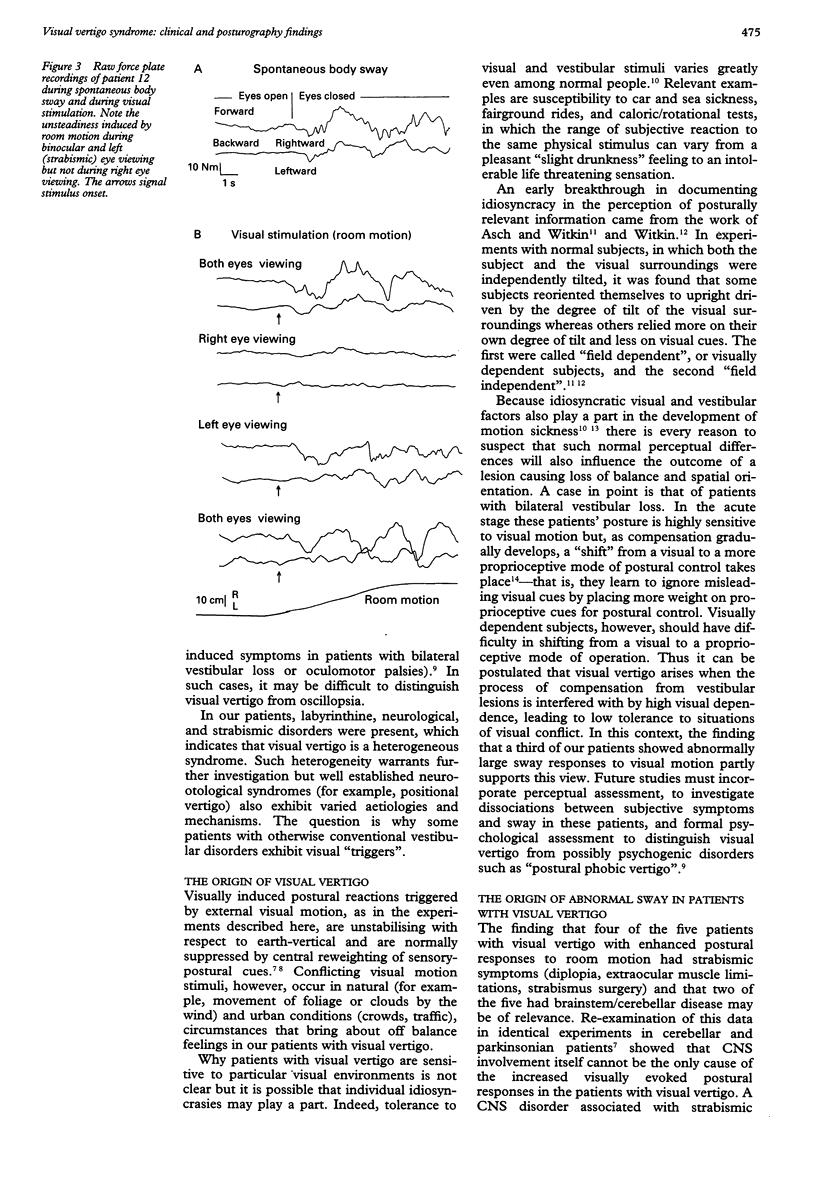Abstract
Neuro-otological and posturography findings in 15 patients with visually induced vertiginous symptoms (visual vertigo) are reported. Thirteen patients were considered to have a peripheral vestibular disorder; seven had abnormal caloric or rotational test results. Two patients had CNS disorder--a cerebellar degeneration and a brainstem stroke. Posturography testing showed that five patients showed abnormally large body sway induced by full field visual motion stimulation. This group included the two patients with CNS disease and four with strabismic symptoms (diplopia, squint surgery, and ocular muscle weakness). It is concluded that visual vertigo is a heterogeneous syndrome with peripheral or central aetiologies and may occur if patients with balance disorders show high visual field dependence. In patients with visual vertigo, the presence of additional CNS or strabismic symptoms may cause inappropriate postural reactions in environments with conflicting or disorienting visual stimuli, probably by reducing the ability to resolve the sensory conflict.
Full text
PDF




Selected References
These references are in PubMed. This may not be the complete list of references from this article.
- Bles W., Vianney de Jong J. M., de Wit G. Compensation for labyrinthine defects examined by use of a tilting room. Acta Otolaryngol. 1983 May-Jun;95(5-6):576–579. doi: 10.3109/00016488309139445. [DOI] [PubMed] [Google Scholar]
- Bronstein A. M., Hood J. D., Gresty M. A., Panagi C. Visual control of balance in cerebellar and parkinsonian syndromes. Brain. 1990 Jun;113(Pt 3):767–779. doi: 10.1093/brain/113.3.767. [DOI] [PubMed] [Google Scholar]
- Bronstein A. M. Suppression of visually evoked postural responses. Exp Brain Res. 1986;63(3):655–658. doi: 10.1007/BF00237488. [DOI] [PubMed] [Google Scholar]
- Gauthier G. M., Nommay D., Vercher J. L. The role of ocular muscle proprioception in visual localization of targets. Science. 1990 Jul 6;249(4964):58–61. doi: 10.1126/science.2367852. [DOI] [PubMed] [Google Scholar]
- Hood J. D. Unsteadiness of cerebellar origin: an investigation into its cause. J Laryngol Otol. 1980 Aug;94(8):865–876. doi: 10.1017/s0022215100089623. [DOI] [PubMed] [Google Scholar]
- Lopez L., Bronstein A. M., Gresty M. A., Rudge P., du Boulay E. P. Torsional nystagmus. A neuro-otological and MRI study of thirty-five cases. Brain. 1992 Aug;115(Pt 4):1107–1124. doi: 10.1093/brain/115.4.1107. [DOI] [PubMed] [Google Scholar]
- Page N. G., Gresty M. A. Motorist's vestibular disorientation syndrome. J Neurol Neurosurg Psychiatry. 1985 Aug;48(8):729–735. doi: 10.1136/jnnp.48.8.729. [DOI] [PMC free article] [PubMed] [Google Scholar]
- Steinbach M. J., Smith D. R. Spatial localization after strabismus surgery: evidence for inflow. Science. 1981 Sep 18;213(4514):1407–1409. doi: 10.1126/science.7268444. [DOI] [PubMed] [Google Scholar]
- WITKIN H. A. The perception of the upright. Sci Am. 1959 Feb;200(2):51–56. [PubMed] [Google Scholar]
- Yardley L. Motion sickness susceptibility and the utilisation of visual and otolithic information for orientation. Eur Arch Otorhinolaryngol. 1990;247(5):300–304. doi: 10.1007/BF00176542. [DOI] [PubMed] [Google Scholar]


